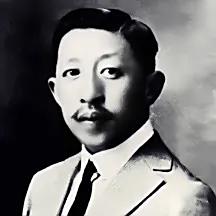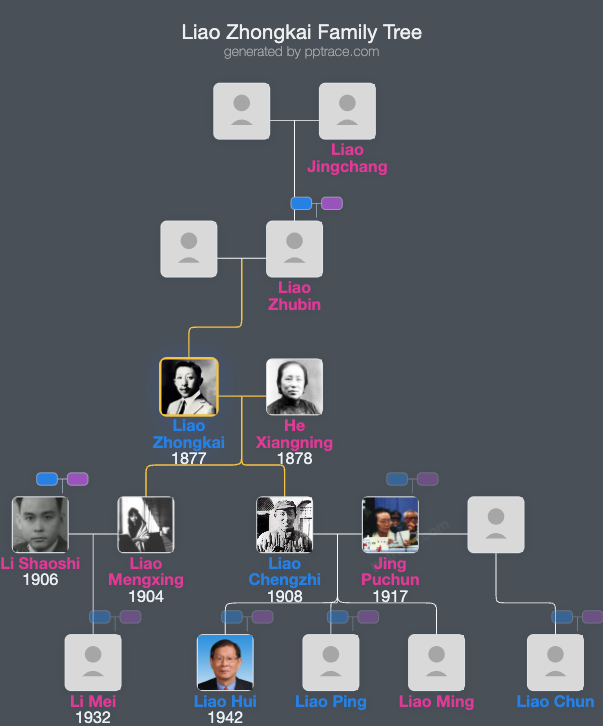
Liao Zhongkai
| Name | Liao Zhongkai |
| Title | Chinese politician (1877-1925) |
| Gender | Male |
| Birthday | 1877-04-23 |
| nationality | United States of America |
| Source | https://www.wikidata.org/wiki/Q708753 |
| pptrace | View Family Tree |
| LastUpdate | 2025-10-01T09:54:06.886Z |
Introduction
Liao Zhongkai was born on April 23, 1877, in San Francisco, United States, into a family of Chinese expatriates working in America. His ancestors were Hakka people who had long resided in Chengjiang Town, Meixian County, Guangdong Province. His father, Liao Zhuben, held positions at HSBC in Hong Kong and San Francisco, and the family was relatively wealthy. After his father’s death in 1893, Liao Zhongkai returned to China with his mother, settling in Guangzhou to live with his uncle, Liao Zhigang, who served as the head of the Shanghai Fishery Administration. Liao Zhongkai completed his secondary education at the Queen’s College in Hong Kong, and in 1897, he married He Xiangning, who was also an important figure in the Chinese Kuomintang’s left wing and later served as a member of the Central People's Government and director of the Overseas Chinese Affairs Committee.
In his early years, Liao Zhongkai was influenced by the First Sino-Japanese War, which inclined him towards Western academic studies. He began attending Queen’s College in Hong Kong in 1896. After the failure of the Hundred Days’ Reform in 1898, he developed an aspiration to study abroad in Japan. He was supported by his wife, He Xiangning, who sold her dowry jewelry to fund their journey. In January 1903, Liao first went to Japan, followed by He Xiangning arriving in Tokyo in April of the same year. The couple met Sun Yat-sen in Japan and were deeply influenced by his revolutionary ideas, deciding to dedicate themselves to overthrowing the Qing dynasty.
In 1904, Liao Zhongkai enrolled in the preliminary economics program at Waseda University, and later studied at Tokyo’s Chuo University. During this period, he and like-minded youths developed revolutionary sentiments aimed at ending Qing rule and assisted Sun Yat-sen in establishing the Chinese Revolutionary Alliance (Tongmenghui) in Japan, where he served as vice president, secretary of foreign affairs, and deputy minister. Their residence in Tokyo became a liaison station for revolutionaries. They had children named Liao Mengxing and Liao Chengzhi.
Following the success of the Xinhai Revolution in 1911, Liao Zhongkai returned to China and held various important positions, including Vice Minister of Finance for the Guangdong Military Government, General Counselor, and Minister of Finance. In 1912, he became the Director of Finance for the Guangdong Military Government and implemented significant fiscal reforms. After the failure of the Second Revolution in 1913, he fled to Japan with Sun Yat-sen. During this period, he helped organize the Chinese Revolutionary Party (Zhonghua Gemingdang), serving as deputy minister of finance in 1915 and continuing to raise military funds.
Starting in 1919, Liao Zhongkai’s revolutionary activities within China deepened. He supported the labor and peasant movements, emphasizing the political empowerment of these classes. In 1921, Sun Yat-sen established the Guangdong Revolutionary Government, with Liao serving as Deputy Minister of Finance and Director of the Provincial Finance Department, actively supporting the Northern Expedition. After negotiating with Soviet representatives like Yue Fei in 1923, he took on the role of Minister of Finance at the Military Headquarters of the Army and Navy, and in 1924, he represented the Chinese Kuomintang at the first National Congress, endorsing cooperation between the Kuomintang and the Chinese Communist Party.
In 1925, Liao Zhongkai played a key role in establishing the Whampoa Military Academy, serving as an assistant to the superintendent. As a prominent figure supporting Sun Yat-sen’s vision, he promoted the implementation of the Kuomintang’s revolutionary policies and supported the labor and peasant movements. After Sun Yat-sen’s death, his influence within the Kuomintang grew, and he became a crucial pillar of reform, advocating for revolutionary progress.
However, on August 20, 1925, Liao Zhongkai was assassinated in Guangzhou at the age of 48. His murder was orchestrated by imperialist forces and right-wing factions within the Kuomintang, marking a significant event in Chinese revolutionary history. Modern memorials dedicated to him include the Liao Zhongkai and He Xiangning Memorial Museum and institutions such as the Zhongkai Agricultural Engineering College named in his honor. His descendants include prominent figures such as his son, Liao Chengzhi, and other family members who have continued to contribute to China’s political and academic spheres.
Family Tree
Tap to expand more relatives
